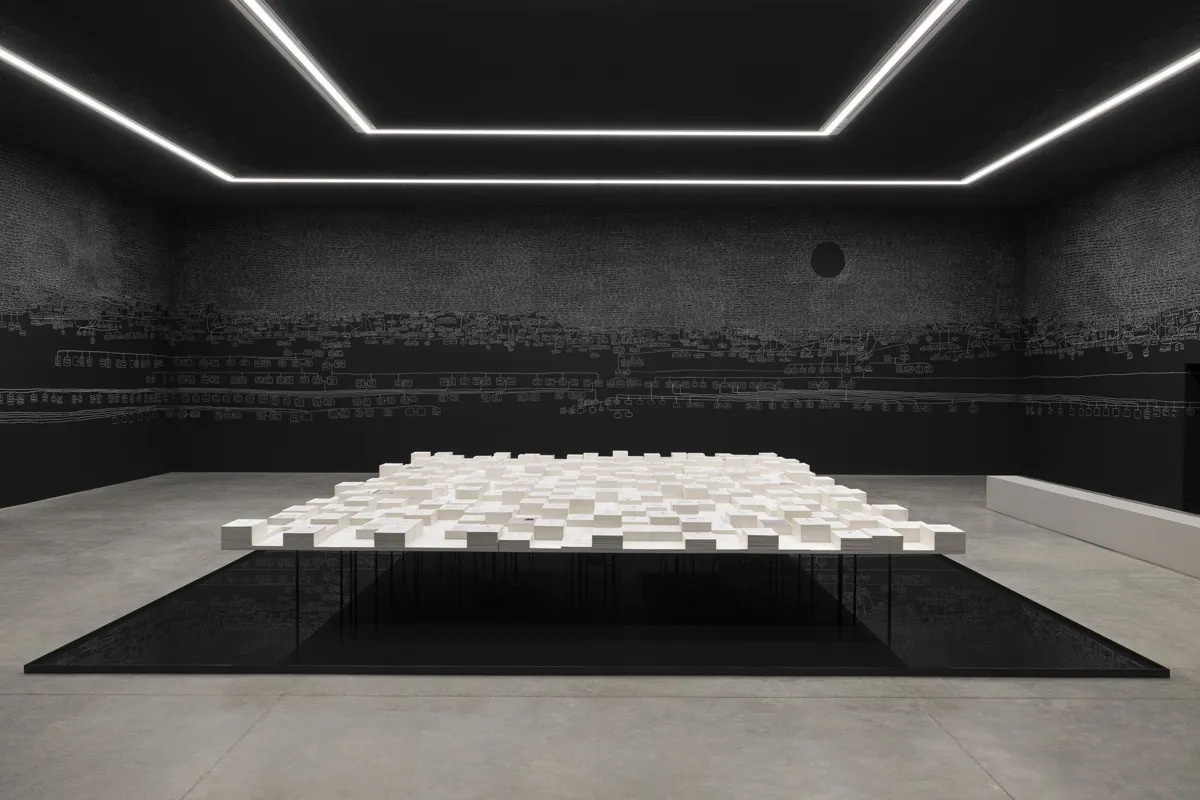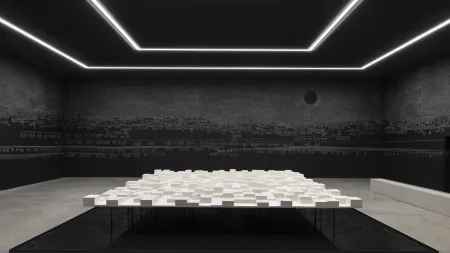
Upon entering the box-shaped Australian Pavilion in the Giardini, the eyes slowly begin to adjust to the crepuscular light. What looks like a white mist slowly materializes on the black walls and envelops visitors. Linger a little and the “mist” crystallizes into a vast family tree going back 65,000 years, hand-written in white chalk across the four 49-by-16-foot walls. Artist Archie Moore, who is of Kamilaroi and Bigambul descent on his mother’s side and British and Scottish on his father’s, has spent four back-breaking weeks inscribing as many names as years on the Pavilion walls and ceiling in tribute to the resilience of Australia’s First Nations people, some of the world’s oldest cultures, despite white colonizers’ concerted efforts to annihilate them. “It shows survival, despite all the horrible things that happened. We’re still here and continuing our cultural practices,” Queensland-based Moore told ARTnews in an interview onsite, ahead of the 2024 Venice Biennale opening later this week.
Indigenous artists figure prominently in the national pavilion line-up at this year’s Biennale, in addition to the main exhibition, “Stranieri Ovunque – Foreigners Everywhere”, which will spotlight marginalized communities globally and is curated by Adriano Pedrosa. Besides Moore, Jeffrey Gibson, a Mississippi Choctaw/Cherokee artist, is representing the United States; Greenlandic artist Inuuteq Storch is representing Denmark; and Glicéria Tupinambá, also known as Célia Tupinambá, is representing Brazil.
Moore’s powerful exhibition “kith and kin” speaks to the vital network of familial ties that underpins First Nations culture and the ignominious history of state attempts to erase it. The long list of abuses includes the forced separation of children from parents, removal from ancestral lands, and prohibition from speaking Indigenous languages, not to mention the numerous massacres throughout colonial rule and the ongoing over-incarceration of First Nations peoples today. The solo show—only the second time an Indigenous artist has represented Australia—feels particularly timely coming on the heels of the country’s 2023 referendum vote against enshrining a First Nations voice in the constitution.
Moore chose the title after discovering a 14th-century definition for the archaic word “kith” meaning “countrymen or of one’s own country,” which he felt aligned with Indigenous understandings of the land itself as being part of their kinship system. The use of chalk on blackboard paint alludes to his educational experience where “there was no mention of Indigenous history,” he said. Amid the delicate white lattice of names are three large black holes, marking a space for silence and grief; these represent a disruption in the genealogical line, Moore said, “whether through a massacre or a viral outbreak, or where the records have been destroyed or haven’t been recorded properly in the first place.” Equally, they might refer to linguistic loss: of up to 700 Indigenous dialects in existence on the continent when the British landed in 1770, fewer than 160 survive today.

The center of the Pavilion is now dominated by a shallow rectangular memorial pool above which stacks of white paper appear to float in the air. On closer inspection these stacks largely comprise coroners’ inquest reports from all over Australia, each documenting a First Nations person’s death in custody— there are more than 550 here, some as recent as last December. The documents sit deliberately close to the water, so visitors are obliged to bow in a gesture of humility to read them. Contrasting with the fragile tactility of the handwritten names on the walls, the neatly typed documents abound in cold officialese with names redacted for the sake of the victims’ families; the recurrent word “death” exerts an accumulating heaviness. These stacks testify to preventable deaths, whether through inhumane treatment or negligence resulting from systemic, ingrained racism. “This work is asking, why is it still happening? Why is there reluctance to do anything about it?” said Moore.
In addition to deaths, the stacks include evidence of state surveillance and control of First Nations people. Moore’s grandparents feature in correspondence between police and the euphemistically called “Protector of Aboriginals,” who in actuality was charged with monitoring the movements of First Nations people, determining whom they married and so on. “There’s a line being drawn from colonization, through the Aboriginal ‘protectors’ to now. And this is what the contemporary legacy of colonization looks like,” said pavilion curator Ellie Buttrose. Currently First Nations people make up 3.8 percent of Australia’s population but 33 percent of the prison population, according to the Australian Bureau of Statistics.

Born in 1970 in the rural town of Toowoomba, outside Brisbane, Moore grew up feeling shame about his heritage. “I was pretending I wasn’t Aboriginal, trying not to be so conspicuous and to be invisible,” he said. “I guess it was a coping strategy at the time.” The family barely spoke of their roots. His mother, who received only four years of schooling, could pass on little knowledge of Indigenous languages to her son, and there seemed to be a rift on his father’s side about the relationship.
Moore’s personal story entwines with the national narrative evoked in the expanse of names covering the pavilion’s walls. The genealogy starts with Moore on the back wall, marked simply as “me”; extending to the left is his father’s side and right his mother’s—much shorter because of the paucity of written records for Aboriginal people. On the lower levels, one finds Christian names that were imposed by missionaries and colonists, often shortened and without a surname, such as might be given to a pet: Old Florrie, Billy, Bernie, Minnie, Old Jack. Dotted among these, racial slurs leap out like a gut punch, as do descriptors that established a racial hierarchy based on the percentage of Aboriginal blood a person had, a hateful reminder of the horrors committed in the name of white supremacy. These latter categorizations were instrumental in giving legal credence for the government to separate First Nations families beginning the mid-1800s until as recently as the 1970s.

Moving higher up the walls and to the ceiling’s edges, the cadence becomes mellifluous, with Kamilaroi and Bigambul names and kinship terms such as Yibaay, Gabudhaa, Marrii, Gambu and Maadhaa. In the upper levels, branches are replaced by tightly packed boxes suggestive of a cellular system or constellation. Variations in the writing’s rhythm create luminescent areas resembling nebulae, heightening the sense that one is looking up at the cosmos. “The words in the ceiling are the ancestors and talk to Kamilaroi belief that when they die, they go up into the stars and in between the stars,” said Moore. “The Kamilaroi people have creation stories related to those constellations and the dark patches in between them.”
Voids hold meaning in this pavilion—from the nameless lacunae on the walls to the blank white documents standing in for coroners’ reports that have not been made public, to the black abyss at the ceiling’s center. “Just because you can’t see names, it doesn’t mean all that space isn’t ancestors; just because people were massacred, it doesn’t mean they didn’t exist. And just because you don’t have the coronial inquest, it doesn’t mean that that person’s death didn’t matter,” said Buttrose.
She added, “Voids aren’t empty.”

Buttrose and Moore have created a dramatic, minimal visual aesthetic for this Pavilion, limited to a black-and-white palette and strong formal geometry. However, the emotional impact is maximal. Viewed en masse, the handwritten names seem to undulate on the flat surface, as if the walls were vibrating, which somehow energizes the space.
There is hope in the reparative gesture of connection effected by Moore’s shrine within a pavilion. Mirrored in the water, the victims of state-sponsored injustice cited in the coronial reports are surrounded by the reflections of thousands of names going back 2,400 generations. Moore reimagines the dead among their kin and ancestors, where they belong, bringing the past, present and future onto the same plane and asserting an Indigenous view of time. The family tree immerses the visitor in its rich foliage, pointing to the interconnectedness not just of First Nations people but of us all.
“If we go back far enough, we all have a common ancestor, it’s talking about how we’re all connected,” Moore said. “Every viewer that enters is connected in a way to this tree, in that we’re all humans living on earth.”
Blockchain Provenance Tracking Promises More Than Eliminating Forgeries and Risk From the Art Market
Inflamed by the War in Gaza, Germany’s Art Scene Is Tearing Itself Apart

We Went to America’s Biggest Aviation Expo. Here’s What We Saw.

Fashion Industry Reacts to Roberto Cavalli’s Death

Today’s deals: $25 off Nintendo Switch, $189 AirPods Pro, $23 Echo Pop speaker, Blink camera sale, more

A Worrywart’s Guide to the 2024 Paris Olympics


